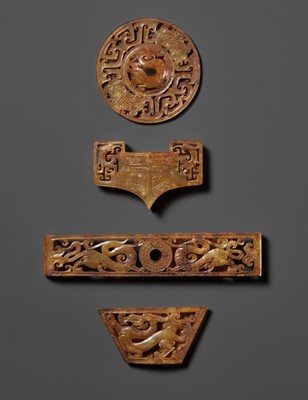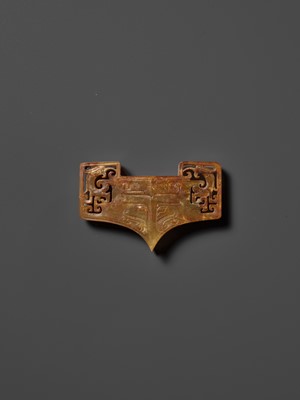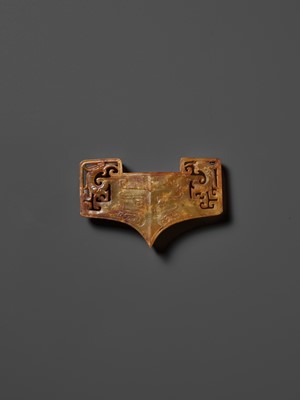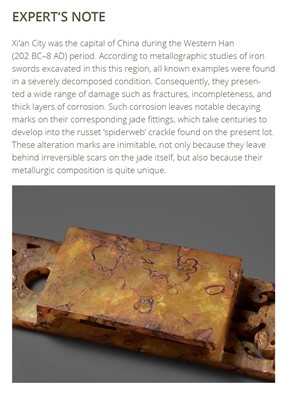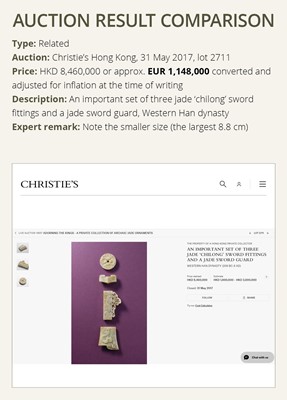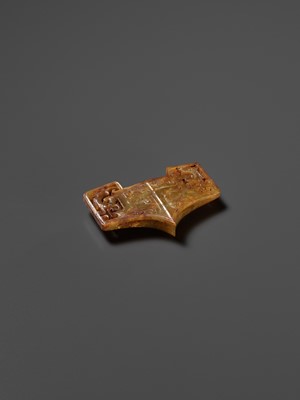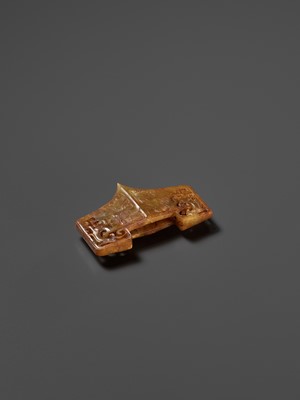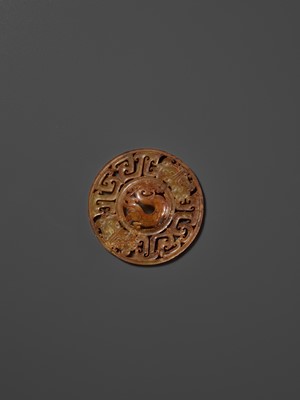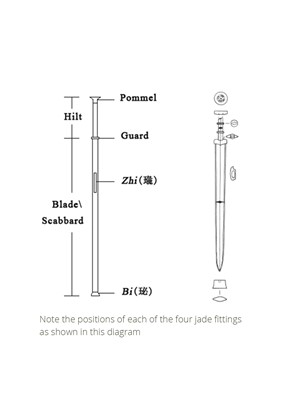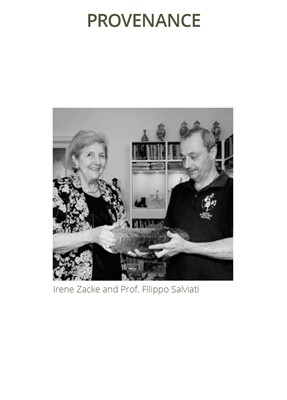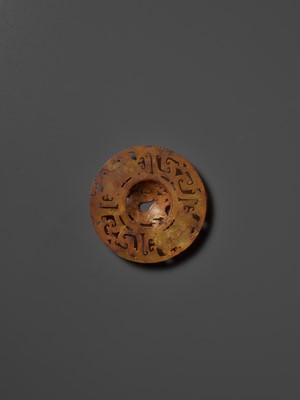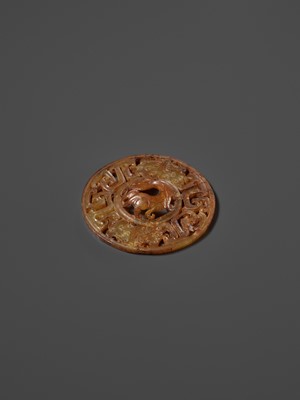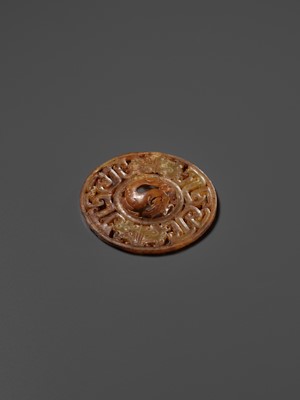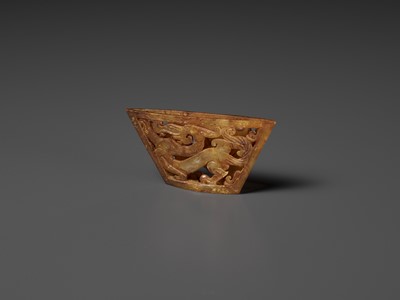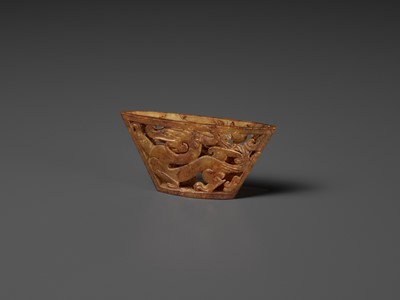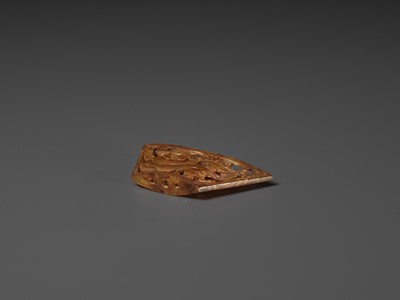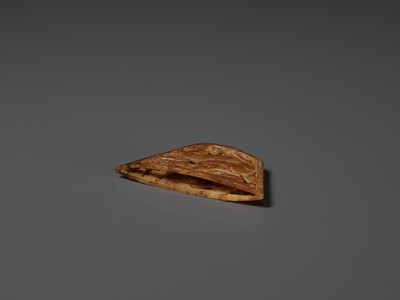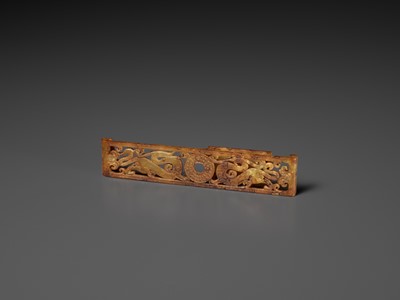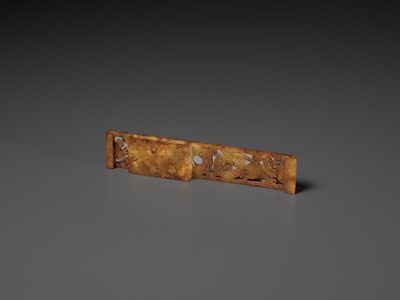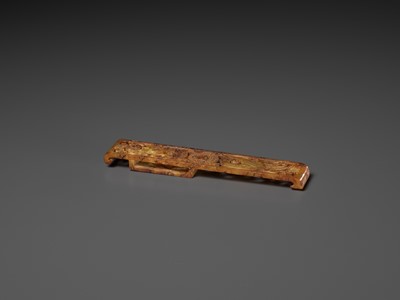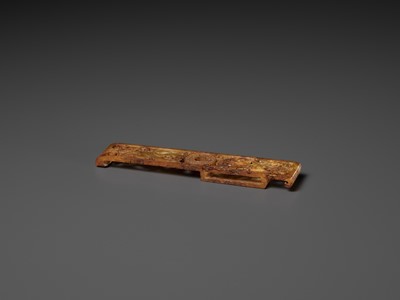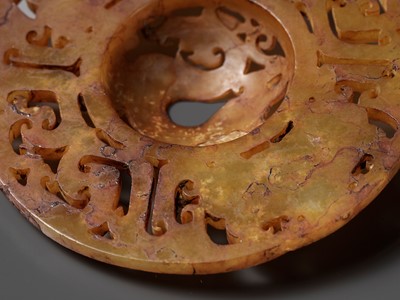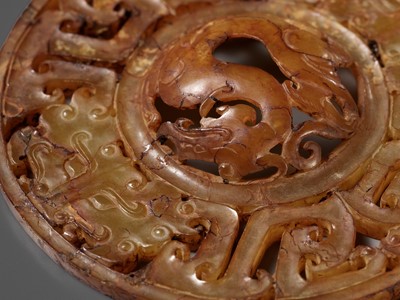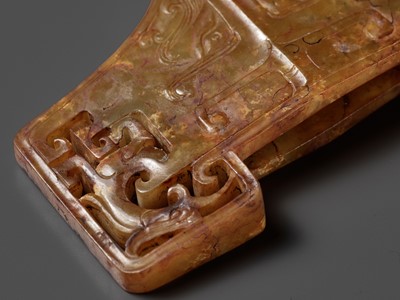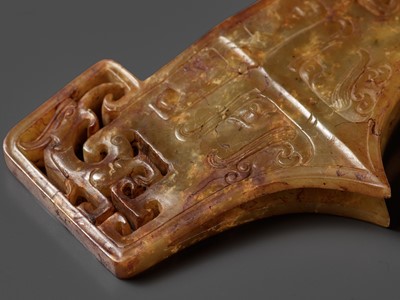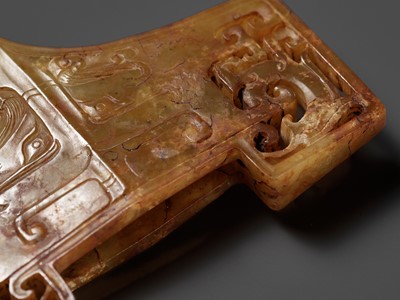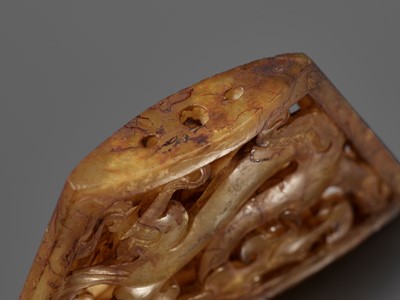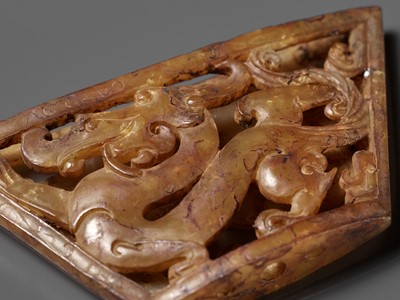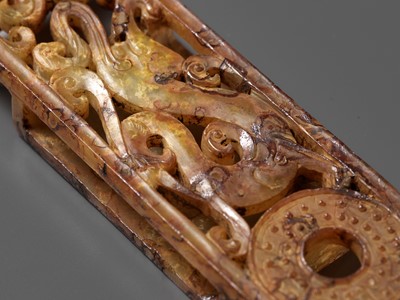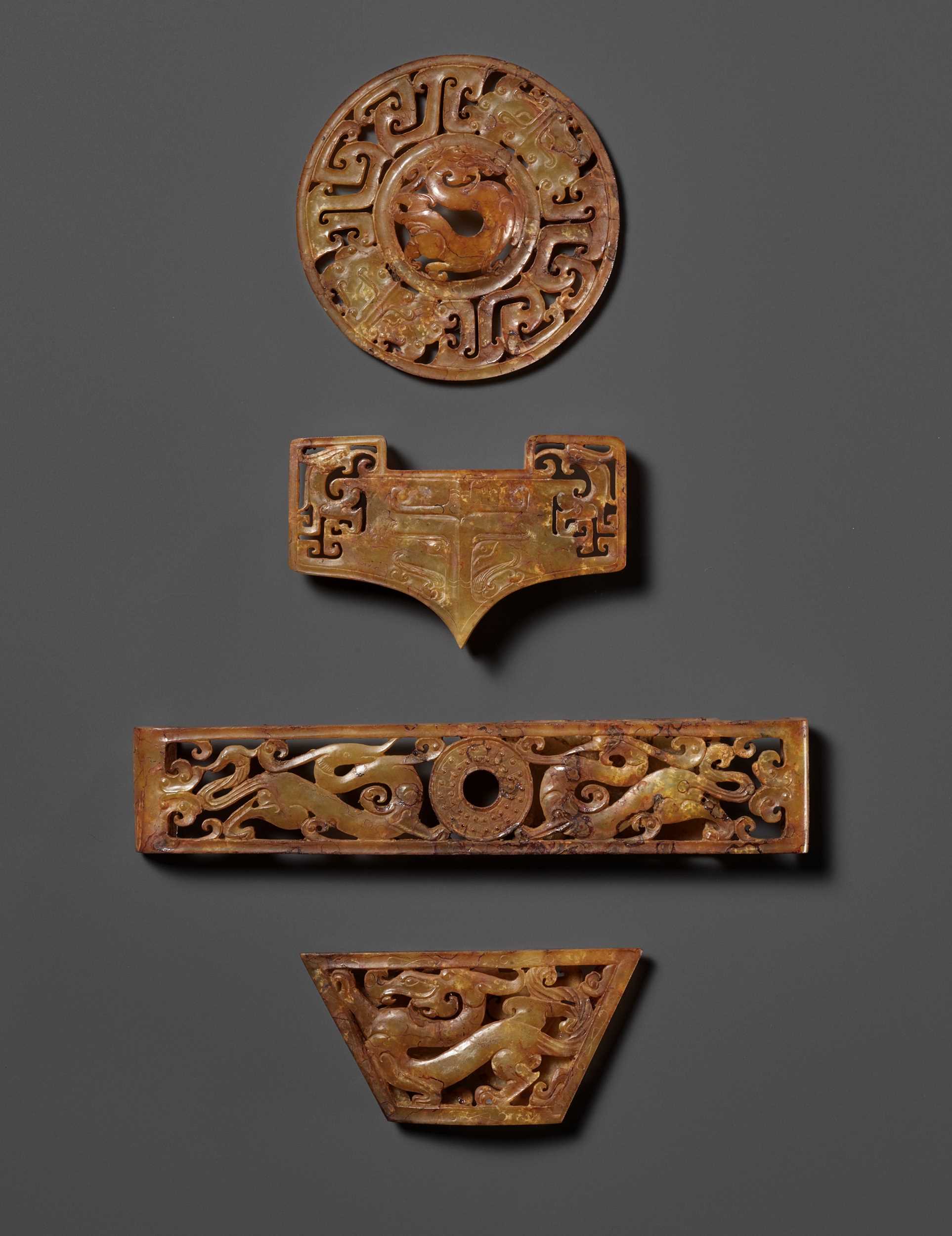29th Sep, 2022 13:00
DAY 1 - TWO-DAY AUCTION - Fine Chinese Art / 中國藝術集珍 / Buddhism & Hinduism
39
A RARE AND COMPLETE SET OF FOUR JADE OPENWORK SWORD FITTINGS, WESTERN HAN DYNASTY
西漢罕見一套四件玉劍飾
Sold for €39,000
including Buyer's Premium
China, 206 BC to 8 AD.
Comprising:
1) A pommel (shou) of circular form, the domed center carved as a dragon, encircled by alternating taotie masks and archaic scroll,
2) A sword guard (ge) carved with central taotie masks to each side, the nose extending to the pointed lower end, flanked by phoenixes and archaic scroll,
3) A scabbard chape (bi) of trapezoidal form carved with sinuously coiled dragons,
4) A scabbard slide (zhi) carved with a central bi disc flanked by two confronting dragons with tails terminating in phoenix heads.
Provenance: From the private collection of Irene and Wolfgang Zacke (1942-2022). The couple has been active in the art trade for well over half a century and were one of the first in Austria to offer Asian works of art in their gallery, starting in 1968. Since the late 1980s, they have been collecting ancient Chinese jades, building an extensive and multiply published collection over the decades.
Condition: Excellent condition, commensurate with age. Expected wear, alterations and weathering, minuscule nibbling and losses, soil and iron rust encrustations. The stone with natural inclusions and fissures, some of which have developed into small hairline cracks over time.
Weight: 113.6 g (total)
Dimensions: Length 14 cm (the scabbard slide), 7 cm (the scabbard chape), and 6.8 cm (the sword guard), Diameter 6.7 cm (the pommel)
The translucent jades are of a fine, greenish-yellow tone with cloudy inclusions, and scattered black speckles. The distinct iron rust encrustation indicates that the jades were buried with a source of iron, doubtlessly the decomposed blade.
Expert’s note: Xi’an City was the capital of China during the Western Han (202 BC–8 AD) period. According to metallographic studies of iron swords excavated in this region, all known examples were found in a severely decomposed condition. Consequently, they presented a wide range of damage such as fractures, incompleteness, and thick layers of corrosion. Such corrosion leaves notable decaying marks on their corresponding jade fittings, which take centuries to develop into the russet ‘spiderweb’ crackle found on the present lot. These alteration marks are inimitable, not only because they leave behind irreversible scars on the jade itself, but also because their metallurgic composition is quite unique.
In ancient China, there were two pathways known for soft iron making: One was the so-called “direct process” in which bloomery iron, with a low-carbon content, was smelted in a furnace and then directly used for smithing larger numbers of lower quality blades. The second, so-called “indirect process” was more complex: After smelting from a blast furnace, cast iron was decarburized through a liquid-state procedure called Chaogang. This produced still-malleable iron with a significantly higher carbon content of up to 1%, or – in other words – steel of the best possible quality for the manufacture of high-end blades. Needless to say, jade was used primarily for fittings of blades from this group, a sign of almost exuberant luxury, marking its owner as a person of nobility. Similar fittings were also found on bronze swords, but only the ones discovered near the remnants of iron blades are encrusted with distinct rust patterns such as the present lot.
This exceptional set of sword fittings exemplifies the best jade carving of the early Western Han period. Note the extreme thinness of the jades in several areas, with some parts of the guard and the chape measuring an incredible 1 mm in thickness.
Literature comparison:
Compare a closely related set of sword fittings once belonging to the King of Nanyue, illustrated in Zhongguo Yuqi Quanji 4 – Qin, Han, Nanbeichao, Hebei, 1993, pp. 60-61, nos. 79-82. Compare four sword fittings from the Myers collection, dated to the Western Han period, published in Fillippo Salviati, Radiant Stones: Archaic Chinese Jades, 2004, Hong Kong, nos. 130-133.
Auction result comparison:
Type: Related
Auction: Christie’s Hong Kong, 31 May 2017, lot 2711
Price: HKD 8,460,000 or approx. EUR 1,148,000 converted and adjusted for inflation at the time of writing
Description: An important set of three jade ‘chilong’ sword fittings and a jade sword guard, Western Han dynasty
Expert remark: Note the smaller size (the largest 8.8 cm)
西漢罕見一套四件玉劍飾
中國,公元前206年至公元8 年。一套四件,含:
玉劍首,鏤空雕刻,作圓餅形,正面中間稍凸作龍紋,周圍一對饕餮紋;
玉劍格,中心有穿孔,以納劍柄。正面浮雕饕餮紋,鼻子延伸,左右鏤空雕刻鳳凰紋,打磨光滑,雕琢規整;
玉劍珌,器面呈梯形。短邊有供劍鞘接榫固定用的圓孔,鏤空雕刻蟠龍紋;
玉劍璏,長條形,略短,兩端內捲,背面有一方孔。面琢雙龍捧璧,龍尾呈鳳首狀。
來源:Irene與 Wolfgang Zacke (1942-2022)。自1968 年起,這對夫婦活躍在藝術貿易界,並且是奧地利最早在其畫廊中提供亞洲藝術品的人之一。1980 年代後期,他們一直在收集中國古代玉器,幾十年來建立了極富多樣性的收藏。
品相:狀況極佳,有磨損、風化、磕損、缺損、土壤結殼與鏽斑。具有天然內沁和裂縫的玉料,隨著時間的推移,其中一些已經發展成細小的裂縫。
重量:總113.6克
尺寸:劍璏長 14 厘米,劍珌7 厘米,劍格6.8 厘米,劍首直徑 6.7 厘米
玉質細膩,有綠色、赭色斑,瑩潤有澤。玉石上明顯的鐵鏽斑。
專家注釋:西安市是西漢(公元前202年-公元8年)時中國的首都。根據對該地區出土的鐵劍的研究,所有已知的例子在發現時都已嚴重腐爛,因此,它們有大面積損壞的情況,例如斷裂和不完整。這種腐蝕在其相應的玉飾配件上留下了痕跡,這些痕跡需要幾個世紀才能發展成如此拍品的黃金褐色沁。它們在玉石上留下了不可逆轉的痕跡,并可因爲它們而可以研究當年的冶金成分。用玉來裝飾劍,在西周便已開始,春秋戰國諸侯爭霸,戰爭頻繁,兵器生產量大,達官貴族為了標榜財富實力,顯示社會地位,表明身份,開始廣泛在所佩之劍上飾玉,成套的玉具劍以西漢時期最為盛行。漢代玉劍飾結構精巧,紋飾生動,體現了很高的藝術與工藝價值,是古代玉器中璀璨奪目的瑰寶。
文獻比較:
比較一件非常相近的一組劍飾,原屬於越王,見《中國玉器全集4‧秦、漢—南北朝》,河北, 1993年,頁60-61,編號79-82。比較一組西漢四件劍飾,出版於Fillippo Salviati,《Radiant Stones: Archaic Chinese Jades》,2004年,香港,編號130-133。
拍賣結果比較:
形制:相近
拍賣:香港佳士得,2017年5月31日,lot 2711
價格:HKD 8,460,000(相當於今日EUR 1,148,000)
描述:西漢玉螭龍紋劍飾一套三件及玉勾雲紋劍格一件
專家評論:請注意尺寸較小(the largest 8.8厘米)。
China, 206 BC to 8 AD.
Comprising:
1) A pommel (shou) of circular form, the domed center carved as a dragon, encircled by alternating taotie masks and archaic scroll,
2) A sword guard (ge) carved with central taotie masks to each side, the nose extending to the pointed lower end, flanked by phoenixes and archaic scroll,
3) A scabbard chape (bi) of trapezoidal form carved with sinuously coiled dragons,
4) A scabbard slide (zhi) carved with a central bi disc flanked by two confronting dragons with tails terminating in phoenix heads.
Provenance: From the private collection of Irene and Wolfgang Zacke (1942-2022). The couple has been active in the art trade for well over half a century and were one of the first in Austria to offer Asian works of art in their gallery, starting in 1968. Since the late 1980s, they have been collecting ancient Chinese jades, building an extensive and multiply published collection over the decades.
Condition: Excellent condition, commensurate with age. Expected wear, alterations and weathering, minuscule nibbling and losses, soil and iron rust encrustations. The stone with natural inclusions and fissures, some of which have developed into small hairline cracks over time.
Weight: 113.6 g (total)
Dimensions: Length 14 cm (the scabbard slide), 7 cm (the scabbard chape), and 6.8 cm (the sword guard), Diameter 6.7 cm (the pommel)
The translucent jades are of a fine, greenish-yellow tone with cloudy inclusions, and scattered black speckles. The distinct iron rust encrustation indicates that the jades were buried with a source of iron, doubtlessly the decomposed blade.
Expert’s note: Xi’an City was the capital of China during the Western Han (202 BC–8 AD) period. According to metallographic studies of iron swords excavated in this region, all known examples were found in a severely decomposed condition. Consequently, they presented a wide range of damage such as fractures, incompleteness, and thick layers of corrosion. Such corrosion leaves notable decaying marks on their corresponding jade fittings, which take centuries to develop into the russet ‘spiderweb’ crackle found on the present lot. These alteration marks are inimitable, not only because they leave behind irreversible scars on the jade itself, but also because their metallurgic composition is quite unique.
In ancient China, there were two pathways known for soft iron making: One was the so-called “direct process” in which bloomery iron, with a low-carbon content, was smelted in a furnace and then directly used for smithing larger numbers of lower quality blades. The second, so-called “indirect process” was more complex: After smelting from a blast furnace, cast iron was decarburized through a liquid-state procedure called Chaogang. This produced still-malleable iron with a significantly higher carbon content of up to 1%, or – in other words – steel of the best possible quality for the manufacture of high-end blades. Needless to say, jade was used primarily for fittings of blades from this group, a sign of almost exuberant luxury, marking its owner as a person of nobility. Similar fittings were also found on bronze swords, but only the ones discovered near the remnants of iron blades are encrusted with distinct rust patterns such as the present lot.
This exceptional set of sword fittings exemplifies the best jade carving of the early Western Han period. Note the extreme thinness of the jades in several areas, with some parts of the guard and the chape measuring an incredible 1 mm in thickness.
Literature comparison:
Compare a closely related set of sword fittings once belonging to the King of Nanyue, illustrated in Zhongguo Yuqi Quanji 4 – Qin, Han, Nanbeichao, Hebei, 1993, pp. 60-61, nos. 79-82. Compare four sword fittings from the Myers collection, dated to the Western Han period, published in Fillippo Salviati, Radiant Stones: Archaic Chinese Jades, 2004, Hong Kong, nos. 130-133.
Auction result comparison:
Type: Related
Auction: Christie’s Hong Kong, 31 May 2017, lot 2711
Price: HKD 8,460,000 or approx. EUR 1,148,000 converted and adjusted for inflation at the time of writing
Description: An important set of three jade ‘chilong’ sword fittings and a jade sword guard, Western Han dynasty
Expert remark: Note the smaller size (the largest 8.8 cm)
西漢罕見一套四件玉劍飾
中國,公元前206年至公元8 年。一套四件,含:
玉劍首,鏤空雕刻,作圓餅形,正面中間稍凸作龍紋,周圍一對饕餮紋;
玉劍格,中心有穿孔,以納劍柄。正面浮雕饕餮紋,鼻子延伸,左右鏤空雕刻鳳凰紋,打磨光滑,雕琢規整;
玉劍珌,器面呈梯形。短邊有供劍鞘接榫固定用的圓孔,鏤空雕刻蟠龍紋;
玉劍璏,長條形,略短,兩端內捲,背面有一方孔。面琢雙龍捧璧,龍尾呈鳳首狀。
來源:Irene與 Wolfgang Zacke (1942-2022)。自1968 年起,這對夫婦活躍在藝術貿易界,並且是奧地利最早在其畫廊中提供亞洲藝術品的人之一。1980 年代後期,他們一直在收集中國古代玉器,幾十年來建立了極富多樣性的收藏。
品相:狀況極佳,有磨損、風化、磕損、缺損、土壤結殼與鏽斑。具有天然內沁和裂縫的玉料,隨著時間的推移,其中一些已經發展成細小的裂縫。
重量:總113.6克
尺寸:劍璏長 14 厘米,劍珌7 厘米,劍格6.8 厘米,劍首直徑 6.7 厘米
玉質細膩,有綠色、赭色斑,瑩潤有澤。玉石上明顯的鐵鏽斑。
專家注釋:西安市是西漢(公元前202年-公元8年)時中國的首都。根據對該地區出土的鐵劍的研究,所有已知的例子在發現時都已嚴重腐爛,因此,它們有大面積損壞的情況,例如斷裂和不完整。這種腐蝕在其相應的玉飾配件上留下了痕跡,這些痕跡需要幾個世紀才能發展成如此拍品的黃金褐色沁。它們在玉石上留下了不可逆轉的痕跡,并可因爲它們而可以研究當年的冶金成分。用玉來裝飾劍,在西周便已開始,春秋戰國諸侯爭霸,戰爭頻繁,兵器生產量大,達官貴族為了標榜財富實力,顯示社會地位,表明身份,開始廣泛在所佩之劍上飾玉,成套的玉具劍以西漢時期最為盛行。漢代玉劍飾結構精巧,紋飾生動,體現了很高的藝術與工藝價值,是古代玉器中璀璨奪目的瑰寶。
文獻比較:
比較一件非常相近的一組劍飾,原屬於越王,見《中國玉器全集4‧秦、漢—南北朝》,河北, 1993年,頁60-61,編號79-82。比較一組西漢四件劍飾,出版於Fillippo Salviati,《Radiant Stones: Archaic Chinese Jades》,2004年,香港,編號130-133。
拍賣結果比較:
形制:相近
拍賣:香港佳士得,2017年5月31日,lot 2711
價格:HKD 8,460,000(相當於今日EUR 1,148,000)
描述:西漢玉螭龍紋劍飾一套三件及玉勾雲紋劍格一件
專家評論:請注意尺寸較小(the largest 8.8厘米)。
Zacke Live Online Bidding
Our online bidding platform makes it easier than ever to bid in our auctions! When you bid through our website, you can take advantage of our premium buyer's terms without incurring any additional online bidding surcharges.
To bid live online, you'll need to create an online account. Once your account is created and your identity is verified, you can register to bid in an auction up to 12 hours before the auction begins.
Intended Spend and Bid Limits
When you register to bid in an online auction, you will need to share your intended maximum spending budget for the auction. We will then review your intended spend and set a bid limit for you. Once you have pre-registered for a live online auction, you can see your intended spend and bid limit by going to 'Account Settings' and clicking on 'Live Bidding Registrations'.
Your bid limit will be the maximum amount you can bid during the auction. Your bid limit is for the hammer price and is not affected by the buyer’s premium and VAT. For example, if you have a bid limit of €1,000 and place two winning bids for €300 and €200, then you will only be able to bid €500 for the rest of the auction. If you try to place a bid that is higher than €500, you will not be able to do so.
Online Absentee and Telephone Bids
You can now leave absentee and telephone bids on our website!
Absentee Bidding
Once you've created an account and your identity is verified, you can leave your absentee bid directly on the lot page. We will contact you when your bids have been confirmed.
Telephone Bidding
Once you've created an account and your identity is verified, you can leave telephone bids online. We will contact you when your bids have been confirmed.
Classic Absentee and Telephone Bidding Form
You can still submit absentee and telephone bids by email or fax if you prefer. Simply fill out the Absentee Bidding/Telephone bidding form and return it to us by email at office@zacke.at or by fax at +43 (1) 532 04 52 20. You can download the PDF from our Upcoming Auctions page.
How-To Guides
How to Create Your Personal Zacke Account
How to Register to Bid on Zacke Live
How to Leave Absentee Bids Online
How to Leave Telephone Bids Online
中文版本的操作指南
创建新账号
注册Zacke Live在线直播竞拍(免平台费)
缺席投标和电话投标
Third-Party Bidding
We partner with best-in-class third-party partners to make it easy for you to bid online in the channel of your choice. Please note that if you bid with one of our third-party online partners, then there will be a live bidding surcharge on top of your final purchase price. You can find all of our fees here. Here's a full list of our third-party partners:
- 51 Bid Live
- EpaiLive
- ArtFoxLive
- Invaluable
- LiveAuctioneers
- the-saleroom
- lot-tissimo
- Drouot
Please note that we place different auctions on different platforms. For example, in general, we only place Chinese art auctions on 51 Bid Live.
Bidding in Person
You must register to bid in person and will be assigned a paddle at the auction. Please contact us at office@zacke.at or +43 (1) 532 04 52 for the latest local health and safety guidelines.

